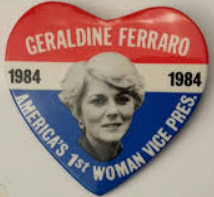Two women have tried doing what Kamala Harris now seeks to do as part of the 2020
Democratic ticket with Joe Biden – win the vice presidency. Their
stories deserve review in our consideration of the historical significance of
the Harris candidacy. Having examined her selection in the context of the fight
for women’s suffrage and early women office holders, we turn now to her
predecessors in the quest and the chance she has of becoming MVP -- Madam Vice
President.
Geraldine Ferraro
Walter Mondale selected New York Congresswoman Geraldine Ferraro as his run-
ning mate in 1984, making her the first
woman on a major party ticket. Some Mondale supporters thought choosing a woman
would galvanize the female vote for Democrats. It didn’t, though Ferraro’s
selection provided Mondale an initial polling jolt. He moved to within striking
distance of incumbent President Ronald Reagan after being down 16 points.
Ultimately, most polls showed a small net gain for the Democratic ticket among
women, but Mondale and Ferraro lost, 59-41, and carried only Washington, D.C.
and Mondale’s native Minnesota.
Ferraro’s candidacy revealed significant sexism in American
politics. First, allegations of financial improprieties in her husband’s real
estate business, which she had little involvement with, blunted the initial
momentum her selection generated. When reporters first questioned Ferraro about
the business, she demonstrated only a modest understanding of the details of a
family owned company in which she technically had one-half interest. Though she
later handled every question at a late August news conference, the damage had
been done.
Vice President George H.W. Bush appeared to patronize Ferraro in their
debate, suggesting he could give her some “help” on foreign policy issues. She
fought back, saying she didn’t appreciate such insults. Most observers at the
time saw the debate as a draw.
Finally, Mondale and Ferraro rarely touched in joint campaign
appearances. She said she feared somebody would say, “Oh my, they’re dating.”
Presumably the country now has a more mature attitude about women in politics. In
2016, Hillary Clinton won almost three million more popular
votes than Donald Trump, the U.S. Senate now includes 26
women, and 101 females hold House seats, including Speaker Nancy Pelosi. Nine women serve as governors. So far, Biden and Harris haven’t
been bashful about clasping raised hands in the traditional show of running
mate solidarity.
Sarah Palin
Chroniclers of the 2008 presidential election almost uniformly regard Republican John McCain’s selection of Alaska Governor Sarah Palin as his biggest mistake in that campaign.
While Ferraro faced skepticism about her foreign policy experience,
she never demonstrated anything suggesting she wasn’t fit for the office. Palin
showed herself totally unprepared. She mumbled about seeing Russia from her
front porch and couldn’t name any news publications she regularly read.
Palin’s selection represented a sort of Hail Mary pass.
McCain trailed Barack Obama badly in the polls and needed
something that would jump start his campaign. Picking Palin initially gave the
ticket a boost, even a brief lead in a few polls. It didn’t last in light of
Palin’s obvious shortcomings. She garnered a cult-like following on the right,
but Obama-Biden won the election by
nearly ten million votes and took the Electoral College, 375-163.
Kamala Harris:
Trailblazer
Even before Biden picked Harris, she’d made her mark on
American politics. As we noted in our history of office
holding by women,
Harris is only the second black woman elected United States Senator, following Carol Mosley Braun, who represented Illinois
1993-99. Harris twice won races for
California Attorney General after serving as San Francisco’s district attorney.
In the Senate, Harris established a
reputation as a tough, well-prepared interrogator in hearings. Those skills could serve her well in
the vice
presidential debate against Mike Pence, an experienced politician who
eagerly defends President Trump’s most outrageous behavior and false
statements. She ran for president, though she dropped out before the 2020
primaries began.
Republicans have struggled in finding a consistent line of
attack against Harris, perhaps demonstrating that they fear her. When Biden
announced her selection, Trump latched on to her grilling of Supreme Court
nominee Brett Kavanaugh as “nasty” and “mean.” Trump later
said electing her would “disgrace” the country, a not-very-thinly-veiled racial
slur. Others tried decrying her immigrant heritage, suggesting she isn’t eligible
for the vice-presidency. Her father came to the United States from Jamaica and
her mother from India, but she was born in Oakland, California, making her as
eligible as any other native born U.S. citizen.
History Unfolding
Harris acknowledges she stands on
many shoulders, like those of Shirley Chisholm, Bella Abzug, Gloria Steinem, Betty Friedan, and the founders of the
National Women’s Political Caucus. The women who fought for suffrage,
the black women who worked for that right against the double whammy of sexism
and racism, and the first women office holders played a part in making the
Harris candidacy possible.
For the moment at least, Harris stands
apart from Ferraro and Palin. The polls say she and Biden have a much better
chance of winning than either of her predecessors.
While we assume she
understands the history and appreciates the opportunity now before her, we also
assume she understands the work ahead. She must stay on message. She must
perform well in the vice presidential debate. She and Biden are, in football
terms, in four down territory and can’t make mistakes.
If they succeed, Harris will honor women like Harriet Tubman, Chisholm, Susan B. Anthony, and Fannie Lou Hamer who blazed trails before her. She
will also, for the young women and girls who follow her, shatter another glass
ceiling.


































